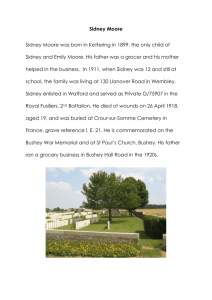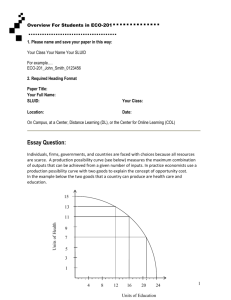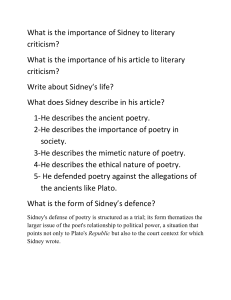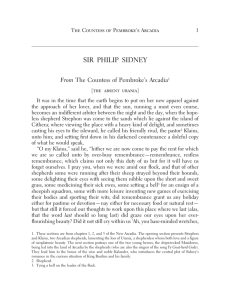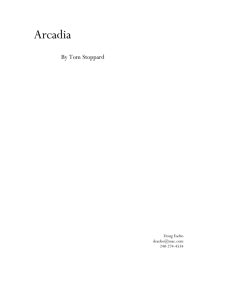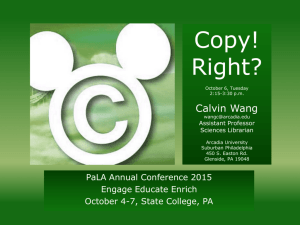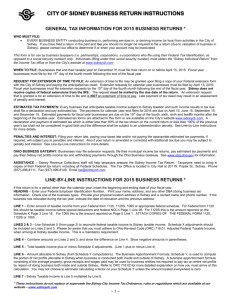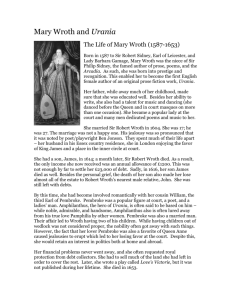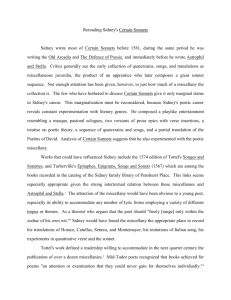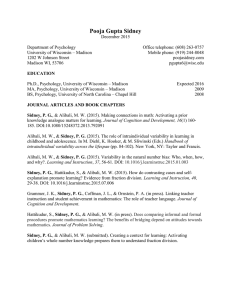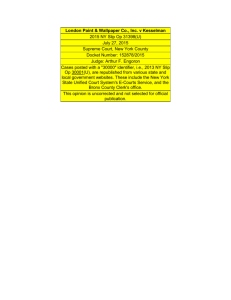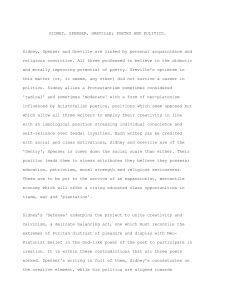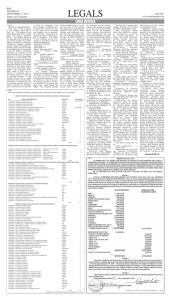Spring 2011 Comprehensive Examination M.A. Program in English
advertisement
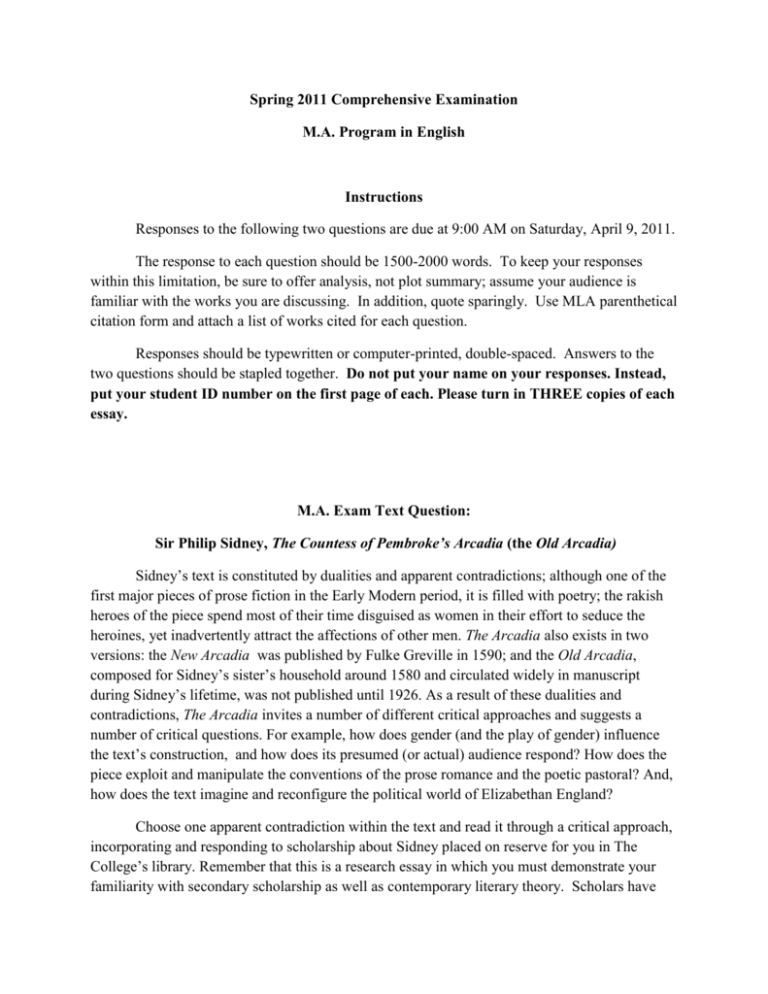
Spring 2011 Comprehensive Examination M.A. Program in English Instructions Responses to the following two questions are due at 9:00 AM on Saturday, April 9, 2011. The response to each question should be 1500-2000 words. To keep your responses within this limitation, be sure to offer analysis, not plot summary; assume your audience is familiar with the works you are discussing. In addition, quote sparingly. Use MLA parenthetical citation form and attach a list of works cited for each question. Responses should be typewritten or computer-printed, double-spaced. Answers to the two questions should be stapled together. Do not put your name on your responses. Instead, put your student ID number on the first page of each. Please turn in THREE copies of each essay. M.A. Exam Text Question: Sir Philip Sidney, The Countess of Pembroke’s Arcadia (the Old Arcadia) Sidney’s text is constituted by dualities and apparent contradictions; although one of the first major pieces of prose fiction in the Early Modern period, it is filled with poetry; the rakish heroes of the piece spend most of their time disguised as women in their effort to seduce the heroines, yet inadvertently attract the affections of other men. The Arcadia also exists in two versions: the New Arcadia was published by Fulke Greville in 1590; and the Old Arcadia, composed for Sidney’s sister’s household around 1580 and circulated widely in manuscript during Sidney’s lifetime, was not published until 1926. As a result of these dualities and contradictions, The Arcadia invites a number of different critical approaches and suggests a number of critical questions. For example, how does gender (and the play of gender) influence the text’s construction, and how does its presumed (or actual) audience respond? How does the piece exploit and manipulate the conventions of the prose romance and the poetic pastoral? And, how does the text imagine and reconfigure the political world of Elizabethan England? Choose one apparent contradiction within the text and read it through a critical approach, incorporating and responding to scholarship about Sidney placed on reserve for you in The College’s library. Remember that this is a research essay in which you must demonstrate your familiarity with secondary scholarship as well as contemporary literary theory. Scholars have used many theoretical approaches to Sidney’s text including textual scholarship (i.e. comparisons of the “New” and “Old” Arcadias), cultural studies, gender/queer theory, reader-response theory, deconstruction, and others. For the purposes of this essay, however, analyze Sidney’s text using one theoretical approach. Your final draft should be properly documented in MLA format and include a "Works Ccited" page. M.A. Exam Theme Question: “Childhood” Whether or not childhood is understood differently in different cultures and/or different time periods has been debated. Using three texts from three different cultures, write a critically and theoretically informed essay that explores the theme of childhood in your chosen texts. Successful responses provide thoughtful and coherent readings of the literary works. Less successful responses may show an obvious difference in the amount of attention offered to each text and may settle for readings that skim the surface. Remember that this essay is a theoretical/research endeavor and, as such, should demonstrate familiarity with a body of critical and theoretical writings as well as your chosen primary texts. Your essay must have an analytically sophisticated thesis and employ secondary sources on the texts you use. Your final draft should be properly documented in MLA format and include a “Works Cited” page. M.A. Exam Poetry Question Spring 2011 You are to choose ONE of the following two poems and write an analysis of it . “Staring at the Sea on the Day of the Death of Another” was published by American poet May Swenson (1913-1989) in 1972; “Necrophiliac,” by the American Rosanna Warren (1953-), who is celebrated as a writer of elegies, was published in 1993. Your analysis should consist of a unified interpretation of the poem drawing directly upon its constitutive elements. Among the elements that you might choose to discuss are imagery, structure, figurative language, tone, formal qualities (including syntax, stanza, and lineation), rhythm, and sound. Your answer will be judged on the coherence of your overall interpretation as well as your insight into how various aspects of the poem enable that interpretation. Staring at the Sea on the Day of the Death of Another May Swenson The long body of the water fills its hollow, slowly rolls upon its side, and in the swaddlings of the waves, their shadowed hollows falling forward with the tide, like folds of Grecian garments molded to cling around some classic immemorial marble thing, I see the vanished bodies of friends who have died. Each form is furled into its hollow, white in the dark curl, the sea a mausoleum, with countless shelves, cradling the prone effigies of our unearthly selves, some of the hollows empty, long niches in the tide. One of them is mine and gliding forward, gaping wide. Necrophiliac* Rosanna Warren More marrow to suck, more elegies to whistle through the digestive track. So help me God to another dollop of death, come on strong with the gravy and black-eyed peas, slop it all in the transcendental stew whose vapors rise and shine in the nostrils of heaven. Distill the belches, preserve the drool as ink: Death, since you nourish me, I’ll flatter you inordinately. Consumers both, with claws cocked and molars prompt at the fresh-dug grave, reaper and elegist, we collaborate and batten in this strictest of intimacies, my throat an empty sepulchre, my tongue forever groping grief forever young. * Necrophiliac: lover of the dead
